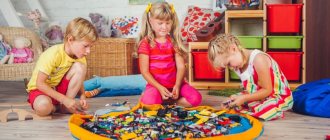“Mathematics puts the mind in order,” i.e. in the best way it forms examples of mental activity and quality of mind, but not only. Its study contributes to the development of memory, speech, imagination, emotions: it forms perseverance, patience, and creative potential of the individual. The main goal of a preschool institution is to prepare children for school.
The content of training is determined by two main lines:
a) prelogical, i.e. preparing the child’s thinking for the application of reasoning methods in mathematics;
b) pre-mathematical, i.e. direct mathematical development of children,
preparing the child’s thinking for mastering basic knowledge in mathematics, i.e. It is not enough to give children some specific knowledge in mathematics. We need to teach children to think, i.e. perform such mental operations as analysis (analysis of a word, analysis of its structure, identification of features), synthesis (mental content into a single whole of parts of an object or its features obtained in the process of analysis), comparison (mental establishment of the similarities or differences of objects), generalization (mental the unification of individual objects in a concept based on similar essential concepts), classification (distribution of objects into groups), abstraction (mental selection of some features of an object and abstractions from others), etc. We need to teach children to guess, to prove.
Psychologists have found that the basic logical structures of thinking are formed between the ages of 4-5 and 10 years. If you begin to form logical thinking later, it will proceed with great difficulties, and often remains unfinished.
Logical-mathematical games refer to the occupied mathematical material. For a long time, in our pedagogy there was a noticeable decline in its use; there was a craze for didacticism; at best, fragments of games, role-playing, and didactic games were used in mathematical development. And now, when occupation, as a form of organizing children in mathematical development, has been abolished in the junior and middle groups, educators still call this work “activity.” We must not forget that the main activity in preschool age is play. The mathematical development of children should occur in a playful, entertaining form, without completely excluding the traditional A.I. Lednina. Thus, one of the lines of a child’s mathematical preparation for school is prelogical, i.e. preparing the child’s thinking for the methods of reasoning used in mathematics. Logic is from the Greek logos - word, concept, reasoning - the science of the laws and operations of correct thinking. The basic principle of logic is that the correctness of reasoning (conclusion) is determined by its logical form (structure), and does not depend on the specific content of the statements included in it, i.e. we give a reasoning scheme in which you can change the content, but the choice will always be correct.
Logic and mathematics are related to each other as parts of the same science (logicism).
A logical game is a way of communicating certain patterns of thinking in a form accessible to children - a game. For example, “Numbers in order” - they are arranged in a random order in the table. The child needs to find and name the numbers in ascending order; “Replace all” (there are 7-8 pictures on the typesetting canvas, children look at it for 10 seconds, then close the pictures, the child must list them in order); “Find the cut out pieces”; "One extra"; “Hoops” (geometric bodies); “Puzzle with sticks”, “Find the missing piece”; “Call it in one word,” etc. Logical-mathematical games are logic games with mathematical content. For example, “Whose pair is faster” (children are divided into pairs and hold hands, children run to the table, quickly put notebooks, textbooks, pens, pencils, etc. scattered on the table into a briefcase. Then they return to their place and tell how many what items were on the table. The fastest and most attentive pair wins. Logical problems, for example, “Two sisters have one brother each. How many children are in the family?” (three); “If a goose stands on two legs, then it weighs 4 kg. How much will a goose weigh if it stands on more than one leg" (4 kg.) If the child cannot cope with the task, then perhaps he has not yet learned to concentrate his attention and remember the condition. Having understood the principle of solving logical problems, the child will be convinced that for the correct solving a logical problem requires concentration, they begin to realize that such an entertaining problem contains a certain “trick” and to solve it it is necessary to understand what the trick is.
Logic games can be classified according to different criteria - by content, purpose, nature of mental operations, i.e. by way of reasoning, by the focus of certain skills, etc. It is more correct to classify by:
- Ways of reasoning: “Which figure is missing?”, “Find the extra one”
- To find signs of similarity and difference: “Labyrinths”
- Recognizing parts as a whole
- Rebuilding the whole from parts
- Continuation of a logical series (seriation)
- Classification. " computing machines"
Most educational psychologists recommend starting work with logical-mathematical games from 5 to 6 years of age (Mikhailova Z.A. “Joiner”). Dyachenko O.M., Agayeva E.L. It is recommended to start introducing educational logical and mathematical games from the age of 3-4. The practice of holding games has shown that the younger and middle groups play with interest and successfully cope with the requirements, but when selecting games, it is necessary to take into account the characteristics of children of a particular group. For example, for children of the second younger group, you need to select games that involve no more than two objects in a logical series. Objects and figures should be familiar to children. In the middle group, the number of objects in a logical series can be increased to five, and counting can be used. In the older group it is increased to ten, i.e. The content of games and methods of reasoning become more complicated.
To expand your pedagogical knowledge on the use of logical and mathematical games in working with children, you need to study relevant literature, such as: “Children's Logic” by L.F. Tikhomirov; “Developing logic and thinking” Cherenkova E.; “Let's Play” Stolyar A.A.; “Game entertaining tasks” Mikhailova Z.A.; Magazine "Preschool Education" No. 1 - 1991. No. 5.9 – 1992 Write a consultation for parents; The book by Stolyar A.A., Sobalevsky “Methodological Instructions” will help prepare a card index of logic games, use it in work, and give homework to children. I found out and studied the methodology that when introducing one type of logical-mathematical games from the simplest to the most complex, we first give an example of a method of reasoning, and then replace the material and invite the child to repeat the game. To work with children, a working algorithm is used: 1) Consider a logical series, each figure.
2) Find the sequence. 3) Consider the second logical series.
4) Compare with the first, noting similarities and differences. 5) Consider the third row. 6) Compare with the second and first, generalize. 7) we draw a conclusion.
Following the ancient proverb: “I hear and I forget, I see and I remember, I do and I understand.” It is necessary to use as much visual material as possible - cards, pictures, toys and counting material; sticks, circles, buttons, etc. The child is interested in the final goal - to fold, find the desired figure, transform - which captivates him.
Various literature suggests applying knowledge in working with children, teaching children to look for solutions, master mental operations and actions using didactic aids “Dienes Logical Blocks”, which is a set of volumetric and flat geometric bodies. Each block is characterized by four properties - shape, color, size, thickness. (Appendix 1.2)
For example, on the card the sequence of block chains is indicated using symbols. In accordance with the indicated pattern, children lay out chains: after the green block comes red, then blue and again green. Kusener rods allow you to simulate a number. This didactic material is a set of sticks in the form of rectangles and cubes. All sticks differ from each other in size and color. This material is sometimes called "color numbers". The criterion for the success of using blocks is the child’s independent successful solution of the problem.
Work practice convinces of the need to use such didactic material and confirms the increase in work efficiency when using entertaining mathematics. Therefore, it is not so important to give preschoolers knowledge of mathematics as to teach them to think logically, develop mathematical thinking, and mathematical abilities to develop logical operations.
Find out what is different and why? These tasks are depicted graphically in tables and grouped by type. Gradually make it more difficult.
- “Insert the missing numbers in the examples”, “Name an object that simultaneously has the following characteristics:
a) has 3 sides and 3 angles.
b) has 5 sides and 5 angles.
- “How are the numbers similar?”
The circles are large and small, black and white. They are divided into two groups. Tasks: determine on what basis the circles are divided - by color, size, color and size.
- “Complete the drawing”, “Make a picture”
- "Mongolian Game", "Columbus Egg"
- “Continue the series of numbers”, “continue the series of objects”
- “Which number is extra in the series and why,” “Which geometric figure is extra and why,” “Extra number.”
Bibliography:
The traditional technique of A.I. Lednina
Logical blocks of Dienesh"
Logic of children" Tikhomirova L.F.
Math games for preschoolers 6-7 years old
Math games for children 6-7 years old are a little more complicated and are suitable for kids who can count at least to 20 and solve examples of addition and subtraction in two steps.
Mathematical game “Fill in the missing number”
The point of this mathematical game is to insert numbers into the empty cells that come in sequence before, between or after a given number.
In this way, the child’s idea of the “number line” is formed.
For convenience, you can first draw this straight line, on which numbers are indicated from left to right, increasing by one each time. Then the baby will understand what “before”, “between” and “after” means, and will easily do all the exercises.
Mathematical game “Put fruits in baskets”
Print the picture, cut out all the fruits and baskets separately. The kid must solve a mathematical example that is written on the fruit and “put” it in the correct basket.
These examples show the child that one number can be obtained in several ways.
Please note that the example does not show the same number of ways to obtain different numbers. So, 7 is obtained in five variants: 4 + 3; 7 – 0; 1 + 6; 2 + 5; 14 – 7. And 18 – in three: 9 + 9; 20 – 2; 12 + 6.
Explain that there are other ways to get the number 18. Give an example or invite your child to come up with his own version.
Mathematical game "Find the right umbrella"
In this math game you need to match the umbrella to each cloud. To do this, the child must solve the examples written inside the cloud and the umbrella, and then place the cloud over the desired umbrella.
In this task, you don’t have to cut anything out, but simply connect the pictures with the same answer. Each cloud corresponds to one umbrella.





